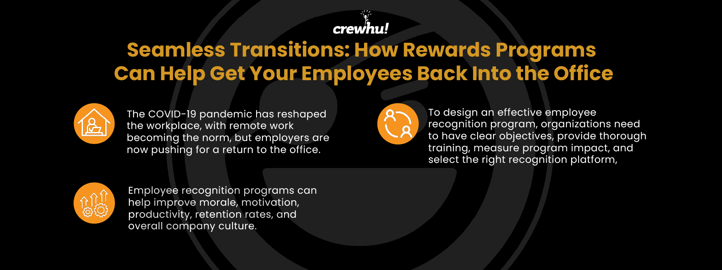Seamless Transitions: How Rewards Programs Can Help Get Your Employees Back Into the Office

With some employees reluctant to return to the office after the pandemic, forward-thinking companies are using incentives to get the team back together.

The COVID-19 pandemic has undeniably reshaped the way we work. As we continue to emerge from the throes of the crisis, the workplace landscape looks dramatically different. Remote work has become the norm for many industries over the past few years, challenging conventional notions of office spaces and work patterns. However, as we move deeper into the post-pandemic world, there’s a push from employers to return to the office.
Just as the transition to remote work was challenging, so was the change back to business, with many workers resisting the return to the office. So how can you navigate these tricky times without losing your best employees?
A workplace culture of respect and appreciation can draw the strongest and most loyal talent. Statistics show that employees are 31% more likely to stick with a job that provides employee recognition programs.
This guide provides a brief overview of employee recognition programs, their benefits, and a few ideas to help you design an effective program for your company that will have employees eager to return to the office.
Benefits of recognition in the workplace
An employee recognition program is a structured and organized initiative to acknowledge and reward employees for their hard work, achievements, and contributions to the company. These programs boost employee morale, motivation, and job satisfaction, improving employee engagement and retention. Employee recognition programs can take various forms, but they all share the common goal of appreciating and valuing employees for their efforts.
The benefits of recognition programs reach far beyond the workplace. They stretch into your employees’ personal lives and make them generally happier people. The key is sincerity. Employees know insincerity, which can feel insulting even when well-meaning. Sincere recognition for a job well done beats an email form letter any day.
Here are some key benefits of sincere recognition in the workplace:
Improved morale
Recognition and appreciation make employees feel valued, which leads to increased job satisfaction and a more positive workplace atmosphere.
Increased motivation
Recognized employees are often more motivated to perform well and consistently contribute to their organizations.
Enhanced productivity
Employees who feel appreciated are typically more engaged and productive, leading to better business results.
Higher retention rates
Employee recognition can help minimize turnover by creating a sense of loyalty and attachment to the organization.
Reinforced company values
Recognition programs aligned with company values help reinforce desired behaviors and cultural norms.
Improved customer service
Motivated employees are more likely to provide excellent customer service, which can positively impact the customer experience.
Talent attraction
A company with a strong recognition program is often seen as an attractive workplace, helping recruit top talent.
Enhanced health and well-being
Positive recognition can reduce stress and promote overall well-being among employees.
Cost savings
High turnover can be costly due to recruitment, training, and lost productivity. Recognition programs can help reduce turnover and associated costs.
Personal growth
Acknowledging employees’ contributions can boost their self-esteem and personal growth, leading to career development.
Positive culture
Recognition programs help cultivate a positive company culture that makes people want to come to work.
Innovation and creativity
Recognizing and rewarding innovative ideas and contributions can foster a culture of creativity.
To maximize these benefits, it’s essential for employee recognition programs to be well-designed, consistently applied, and aligned with the company’s values and culture. Different employees may be motivated by different types of recognition, so various approaches may be necessary to cater to diverse preferences and needs.
Creating an employee recognition program
To design an effective recognition program for your business, you need to follow a systematic approach, ensuring that it aligns with the company’s culture, values, and objectives. Here’s how:
Begin with the basics
Start with clear, measurable objectives. Budget for software and rewards, communicate program rules via company-wide training and consider scalability for global operations.
Get everyone onboard
Focus on thorough training and clear communication for a successful launch. This means teaching all employees, from top executives to individual contributors, how to use the program and why it matters to your company’s culture. Make sure everyone understands the program’s purpose and how it works, especially your managers. Managers play a central role in building a culture of recognition, so be sure they understand how and when to recognize their teams. Include an analytics component in your training so that managers can measure employee engagement and track improvements using monthly key performance indicators (KPIs).
Measure the results
Measuring performance in key business areas, such as retention, engagement, or customer satisfaction, is essential to the success of any employee recognition program. This data provides tangible evidence of the program’s impact on your organization’s bottom line so everyone can see the benefit.
Employee feedback is also important to the success of a recognition program. Regularly seek input through pulse surveys or focus groups. This direct input provides valuable insights into how employees perceive the recognition program and offers inspiration for enhancing your recognition strategy.
Find the correct recognition platform
Selecting the right recognition platform is crucial. Opt for a platform that allows you to provide recognition throughout your organization. It should also seamlessly integrate with other tools you use in the workplace to ensure it doesn’t disrupt daily workflows.
Also, consider the post-implementation support services offered by the platform provider. Customer success managers can customize your employee recognition program, create engagement strategies, and effectively implement the platform to maximize its benefits.
A company’s success depends on the success of its employees. Bringing them back into the office after years of remote work takes concentrated effort, sincerity, and a genuine connection with your staff. Just pulling them in isn’t good enough. You have to make it worth their time and give them a reason to return to the office. And a well-executed employee recognition program can do just that.
Crewhu knows what you need in an employee recognition system
A happy crew is the first step to business success. And the best part is that making it happen can be a lot of fun. If you’re ready to find out how gamification and recognition can help scale your business to new heights of success, book a demo with Crewhu today to discover how our cutting-edge platform can work for you.
Topics: employee recognition, employee retention, gamification, Company Culture, Employee Rewards Program, employee rewards, office transition, office return







